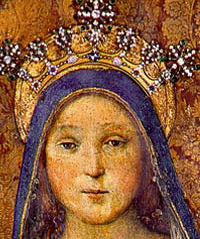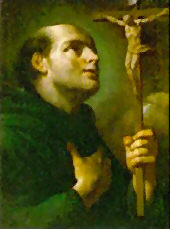Ordinary Time: August 22nd
Memorial of the Queenship of the Blessed Virgin Mary
Other Commemorations: St. Timothy of Rome and St. Symphorian, Martyrs (RM); St. Philip Benize, Priest (RM)
» Enjoy our Liturgical Seasons series of e-books!
The faithful, under the guidance of an unerring Catholic instinct, have ever recognized the queenly dignity of the Mother of "The King of kings and Lord of lords": the Fathers, the Doctors of the Church, Popes, down through the centuries, have given authoritative expression to this truth and the crowning testimony to this common belief is to be found clearly expressed in the wonders of art and in the profound teaching of the liturgy. In their turn theologians have shown the fitting nature of this title of Queen as applied to the Mother of God, since she was so closely associated with the redemptive work of her Son and is the Mediatrix of all graces. Pius XII, by his encyclical letter of October 11, 1954, granted the unanimous desire of the faithful and their pastors and instituted the feast of the Queenship of Mary, giving sanction thus to a devotion that was already paid by the faithful throughout the world to the sovereign Mother of heaven and earth.
According to the 1962 Missal of Bl. John XXIII the Extraordinary Form of the Roman Rite, today is the feast of the Immaculate Heart of the Blessed Virgin Mary which is celebrated in the Ordinary Rite on the Saturday following the Second Sunday after Pentecost.
It is also the commemoration of Sts. Timothy, Hippolytus and Symphorian. St. Timothy is a Roman martyr put to death in 303 or 306 during the last persecution. His body lies at St. Paul's-Outside-the-Walls, near that of the great Apostle. The history of St. Hippolytus, martyred at Ostia, near Rome, remains extremely obscure; it is probably in error that he is called bishop of Porto. St. Symphorian was a martyr of Autun, put to death while still a young man in the second or third century. He is one of the great saints of Gaul and several churches were built in his honor. His Acts appear to be genuine.
Queenship of Mary
 With the certainty of faith we know that Jesus Christ is king in the full, literal, and absolute sense of the word; for He is true God and man. This does not, however, prevent Mary from sharing His royal prerogatives, though in a limited and analogous manner; for she was the Mother of Christ, and Christ is God; and she shared in the work of the divine Redeemer, in His struggles against enemies and in the triumph He won over them all. From this union with Christ the King she assuredly obtains so eminent a status that she stands high above all created things; and upon this same union with Christ is based that royal privilege enabling her to distribute the treasures of the kingdom of the divine Redeemer. And lastly, this same union with Christ is the fountain of the inexhaustible efficacy of her motherly intercession in the presence of the Son and of the Father.
With the certainty of faith we know that Jesus Christ is king in the full, literal, and absolute sense of the word; for He is true God and man. This does not, however, prevent Mary from sharing His royal prerogatives, though in a limited and analogous manner; for she was the Mother of Christ, and Christ is God; and she shared in the work of the divine Redeemer, in His struggles against enemies and in the triumph He won over them all. From this union with Christ the King she assuredly obtains so eminent a status that she stands high above all created things; and upon this same union with Christ is based that royal privilege enabling her to distribute the treasures of the kingdom of the divine Redeemer. And lastly, this same union with Christ is the fountain of the inexhaustible efficacy of her motherly intercession in the presence of the Son and of the Father.
Without doubt, then, does our holy Virgin possess a dignity that far transcends all other creatures. In the eyes of her Son she takes precedence over everyone else. In order to help us understand the preeminence that the Mother of God enjoys over all creation, it would help to remember that from the first moment of her conception the holy Virgin was filled with such a plenitude of grace as to surpass the graces enhancing all the saints. Recall what our predecessor Pius IX, of blessed memory, wrote in his Bull Ineflabilis Deus: "More than all the angels and all the saints has God ineffable freely endowed Mary with the fullness of the heavenly gifts that abound in the divine treasury; and she, preserving herself ever immaculately clean from the slightest taint of sin, attained a fullness of innocence and holiness so great as to be unthinkable apart from God Himself, a fullness that no one other than God will ever possess."
Spurred on by piety and faith, may we glory in being subject to the rule of the Virgin Mother of God; she bears the royal sceptre in her hand, while her heart is ever aflame with motherlove.
—Excerpted from Ad Caeli Reginam, Pius XII
Patronage: diocese of Cabinda, Angola
Highlights and Things to Do:
- Read Pius XII's Encyclical Ad Caeli Reginam (On Proclaiming The Queenship Of Mary)
- Read Pope Benedict's XI's General Audience on the Queenship of Mary.
- From the Father Most Theological Collection read the Queenship of Mary.
- Read more about the Queenship of Mary
- Read Our Beautiful Queen: Lessons on the Queenship of Mary.
- Pray this short devotional Litany of the Queenship of Mary.
- Visit Catholic Cuisine for some feast day food ideas.
Sts. Timothy; St. Symphorian
 Saints Timotheus and Symphorian, martyrs whose feast is observed on August 22. During the pontificate of Melchiades (311-314), St. Timotheus came from Antioch to Rome, where he preached for fifteen months and lived with Sylvester, who later became pope. The prefect of the city, Tarquinus Perpenna, threw him into prison, tortured, and finally beheaded him in 311. A Christian woman named Theon buried him in her garden, This is related in the legend of Sylvester. The name of Timotheus occurs in the earliest martyrologies.
Saints Timotheus and Symphorian, martyrs whose feast is observed on August 22. During the pontificate of Melchiades (311-314), St. Timotheus came from Antioch to Rome, where he preached for fifteen months and lived with Sylvester, who later became pope. The prefect of the city, Tarquinus Perpenna, threw him into prison, tortured, and finally beheaded him in 311. A Christian woman named Theon buried him in her garden, This is related in the legend of Sylvester. The name of Timotheus occurs in the earliest martyrologies.
According to a legend of the early fifth century, St. Symphorian of Autun was beheaded, while still a young man, during the reign of Marcus Aurelius. His mother, the Blessed Augusta, encouraged him on his way to execution, August 22, 178. Bishop Euphronius (d. 490) built a handsome church over his grave, connected with a monastery, which belonged to the Congregation of Sainte-Geneviève from 1656 until its suppression in 1791. Abbot Germanus later became Bishop of Paris, where he dedicated a chapel to the saint. St. Symphorian is the patron saint of Autun. His veneration spread at an early date through the empire of the Franks. His cult was especially popular at Tours; St. Gregory relates a miracle wrought by the saint.
Although these two saints were unrelated, lived in different locations and died at separate times, they are honored together on the same day.
—Excerpted from the Catholic Encyclopedia
Patronage of St. Symphorian: against eye problems; against syphilis; children; students; Autun, France
Symbols and Representation: St. Symphorian: young man being dragged to martyrdom while his mother encourages him
Highlights and Things to Do:
- Read more on these saints:
- View The Martyrdom of Saint Symphorian, by Jean-Auguste-Dominique Ingres.
- St. Timothy's relics are located in the Basilica of St. Paul Outside the Walls in Rome.
St. Philip Benize (or Benozzi)
 St. Philip had special talents for leadership and organization; he was the second founder of the Servites and a great missioner. Of him the Breviary says: "His love and sympathetic consideration for the poor was truly remarkable. On one occasion he gave his own clothing to a destitute leper at Camiliano, a village near Siena, and immediately the poor, sick beggar was healed. The report of the miracle spread far and wide, and many of the cardinals who had assembled at Viterbo after the death of Clement IV (1268) for the election of Christendom's chief shepherd were minded to choose Philip, whose angelic life and mature wisdom were universally acknowledged. But as soon as the saint became aware of this, he went into hiding upon a hill until Gregory X (1271-1276) had been elected; for he sought to be spared that burdensome dignity."
St. Philip had special talents for leadership and organization; he was the second founder of the Servites and a great missioner. Of him the Breviary says: "His love and sympathetic consideration for the poor was truly remarkable. On one occasion he gave his own clothing to a destitute leper at Camiliano, a village near Siena, and immediately the poor, sick beggar was healed. The report of the miracle spread far and wide, and many of the cardinals who had assembled at Viterbo after the death of Clement IV (1268) for the election of Christendom's chief shepherd were minded to choose Philip, whose angelic life and mature wisdom were universally acknowledged. But as soon as the saint became aware of this, he went into hiding upon a hill until Gregory X (1271-1276) had been elected; for he sought to be spared that burdensome dignity."
Philip died at Todi in Tuscany. During his last hours he requested the attending Brother to bring him his book. The Brother did not understand what he meant. "The crucifix," the saint added. That was the book the saint had studied all the days of his life.
—Excerpted from The Church's Year of Grace, Pius Parsch
Patronage: Sergio Osmena, Zamboanga del Norte, Philippines
Symbols and Representation: Chariot; olive branch; red robes; surgical instruments; two angels holding three crowns
Highlights and Things to Do:
- In the former Collect for St. Philip, the Church focused attention upon humility as our saint's most noteworthy virtue: "In the life of St. Philip You have provided for us a splendid example of humility." The manual from which he learned this virtue was the Crucifix. Say the Prayer Before A Crucifix and spend a little time meditating on Our Lord's humility.
- Read more about St. Philip:
- Read the story of how slapping a saint transformed a life...to sanctity.
- See the statue of St. Philip in St. Peter's Colonnade.
- Read more about the Order of Servites and Servants of Mary.






